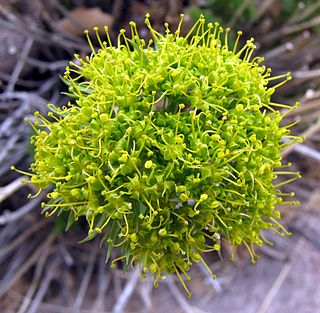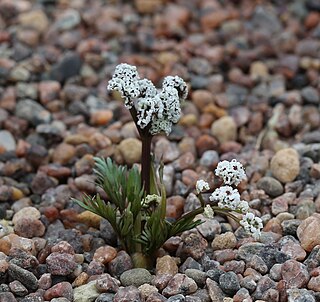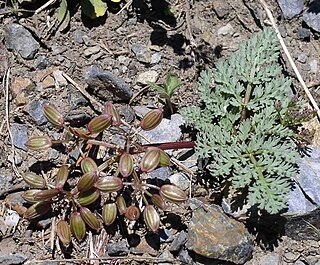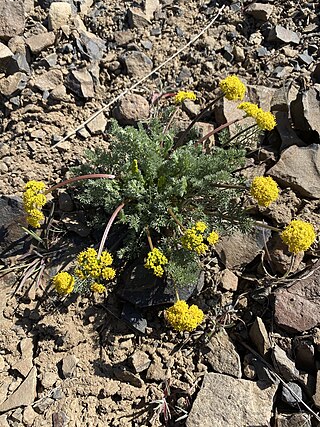
Lomatium parryi, commonly known as Parry's biscuitroot and Utah desertparsley, is a perennial herb in the carrot family. It is a common herb in high altitude areas of deserts and common in desert national parks, such as the mountains surrounding Death Valley, in the western part of the United States.

Lomatium brandegeei, also known as Brandegee's desert-parsley is a perennial herb of the family Apiaceae that is found in the mountains of Washington and southern British Columbia.

Lomatium canbyi is a species of flowering plant in the carrot family known by the common name Canby's biscuitroot. It is native to the Pacific Northwest of the United States and northeast California, where it grows east of the Cascade ridge in sagebrush-covered plateau habitat and barren flats.

Lomatium columbianum is a perennial herb of the family Apiaceae known by the common names purple leptotaenia and Columbia desert parsley. It is endemic to the U.S. states of Oregon and Washington, mostly along the Columbia River east of the Cascades.

Lomatium cuspidatum is a perennial herb of the family Apiaceae, native to the U.S. state of Washington. It is found primarily on open rocky slopes in the Wenatchee Mountains, strongly associated with serpentine scree and soils.

Lomatium gormanii, with the common names Gorman's biscuitroot and salt & pepper, is a perennial herb of the family Apiaceae. It is endemic to the Northwestern United States, in Idaho, Oregon, and Washington, being found in steppes and montane environments. It is called sasamít̓a, sasamít̓aya, and łałamít̓a in the Sahaptin language.

Lomatium grayi, commonly known as Gray's biscuitroot, Gray's desert parsley, or pungent desert parsley, is a perennial herb of the family Apiaceae. It is native to Western Canada in British Columbia, and the Western United States, including from the Eastern Cascades and northeastern California to the Rocky Mountains.
Lomatium marginatum is a species of flowering plant in the carrot family known by the common name butte desertparsley. It is endemic to California, where it is known from mountains, valley, and grassland habitat, including serpentine, in the northern half of the state. It is a perennial herb growing up to about half a meter tall from a small taproot. There is no stem, and the leaves and inflorescence emerge from ground level. The purple-green leaves may approach 30 centimeters long, their blades divided into many long, narrow segments. The short but wide inflorescence bears an umbel of yellowish, purplish, or reddish flowers. The Lomatium marginatum is not currently an endangered species.

Lomatium mohavense is a species of flowering plant in the carrot family known by the common name Mojave desertparsley. It is native to southern California with a few outlying populations in Arizona, Nevada and Baja California. It is found in several types of mountain and desert habitat, including chaparral, woodland, and scrub, mostly from 2,000–7,000 feet (600–2,100 m) elevation.
Lomatium shevockii is a rare species of flowering plant in the carrot family known by the common name Owens Peak desertparsley, or Owens Peak lomatium. It is endemic to Kern County, California, where it is known from only two occurrences at Owens Peak, one of the highest points of the Sierra Nevada. It is a plant of the talus and wooded slopes of the high mountains. This species was discovered in 1984 and first described to science in 1988.

Lomatium stebbinsii, known by the common name Stebbins' desertparsley, is a rare species of flowering plant in the carrot family.

Lomatium tracyi is a species of flowering plant in the carrot family known by the common name Tracy's desertparsley, or Tracy's lomatium. It is native to the mountains of northern California and southern Oregon, where it grows in the forests on the slopes, often on serpentine soils. It is a perennial herb growing up to 35 centimeters tall from a slender taproot. There is generally no stem, the leaves and inflorescence emerging at ground level. The leaf blades are divided and subdivided into a mass of overlapping threadlike to oval segments. The inflorescence is an umbel of yellow flowers.

Lomatium vaginatum is a species of flowering plant in the carrot family known by the common name broadsheath desertparsley. It is native to northern California and adjacent sections of Oregon and Nevada on the Modoc Plateau. It grows in sagebrush, woodland, and other local habitat. This is a perennial herb growing up to 45 centimeters long from a thick taproot. The leaf blades are divided and subdivided into narrow segments. Leaves higher on the stem are enclosed in sheaths. The inflorescence is an umbel of yellow flowers.

Lomatium erythrocarpum, known by the common name redfruit desertparsley, is a rare species of flowering plant in the carrot family. It is endemic to Oregon in the United States, where it is limited to a section of the Blue Mountains within Baker County.

Lomatium greenmanii is a rare species of flowering plant in the carrot family known by the common names Greenman's desertparsley and Greenman's biscuitroot. It is endemic to Oregon in the United States, where it is found only in the Wallowa Mountains of Wallowa County.

Erigeron poliospermus is a species of flowering plant in the family Asteraceae known by the common names gray-seeded fleabane, purple cushion fleabane, and hairy-seed fleabane. Native to western North America, it is mainly found to the east of the Cascade Range in Washington, Oregon, and Idaho.

Lomatium orientale, commonly known as salt-and-pepper, eastern cous, eastern desert-parsley, eastern lomatium, white-flowered desert-parsley, oriental desert parsley or Northern Idaho biscuitroot, is a small spring blooming ephemeral plant. It grows in open habitats from the plains to foothills in western North America. It is known as one of the earliest blooming native flowers in its habitat. The species name, "orientale", is botanical Latin meaning "eastern".

Lomatium quintuplex is a perennial herb in the carrot family Apiaceae, native to the U.S. state of Washington, and known by the common name Umtanum desertparsley. It grows in thin rocky soil on open slopes and is known only from a small region in Kittitas and Yakima counties.

Townsendia florifera is a low growing herbaceous flowering plant in the family Asteraceae, with the common name showy Townsendia.

Tauschia stricklandii is a perennial herb in the Apiaceae family with the common name Strickland's umbrella-wort. It is a narrow endemic that is found mostly in meadows around Mount Rainier.




















